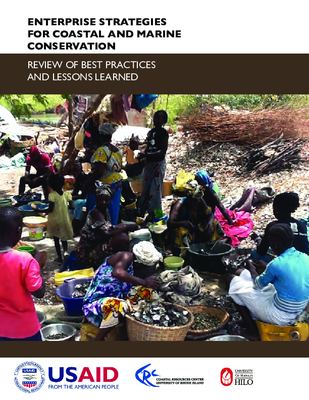Enterprise Strategies for Coastal and Marine Conservation: Review of Best Practices and Lessons Learned

Key points in document
- This review was developed by USAID’s Sustainable Coastal Communities and Ecosystems (SUCCESS) project, implemented between 2004 and 2008.
- The intent of this review of best practices and lessons is to assist coastal practitioners and local government officials to promote enterprise strategies in coastal communities with the intent of simultaneously promoting biodiversity conservation and poverty alleviation, and to achieve both objectives on a sustainable (self-financing) basis.
- The review assumes that the enterprise strategies are embedded in a systems approach to conservation that addresses the major structural barriers to conservation (e.g., open access, weak institutions).
- SUCCESS supported a cross-site learning agenda focused on the factors that contribute to the effectiveness of an enterprise approach to coastal community poverty reduction and biodiversity conservation. Lessons were drawn from seven case studies from Africa, Latin America, and the South Pacific. However, the learning approach was not designed around a common cross-site development hypothesis or theory of change.
- The review compiles many resources for conservation enterprises, highlighting which documents are most useful for each step in the process of enterprise development. The review draws on lessons from various case studies. A more detailed summary of these findings is found in Enterprise Strategies for Coastal and Marine Conservation: A Summary of Best Practices.
Information relevant to Learning Questions:
Are enabling conditions in place to support a sustainable enterprise?
- Stakeholder alignment, diversification
- Market demand, profit potential, credit/capital
- Ownership
- Financial management capacity, technical capacity
- Inputs
- Benefit sharing, targeted participants, combined interventions, biodiversity linkage, policies for and enforcement of resource use
Does the enterprise lead to benefits to stakeholders?
- Increased income for participants
- Non-cash benefits
Do the benefits lead to positive changes in attitudes and behavior?
- Attitudes regarding sustainable use of resources
- Behaviors regarding sustainable use of resources
Does a change in stakeholders’ behaviors lead to a reduction to threats to biodiversity (or restoration)?
- Biological resource use
Does a reduction in threats (or restoration) lead to conservation?
- Marine ecosystems
- Species

